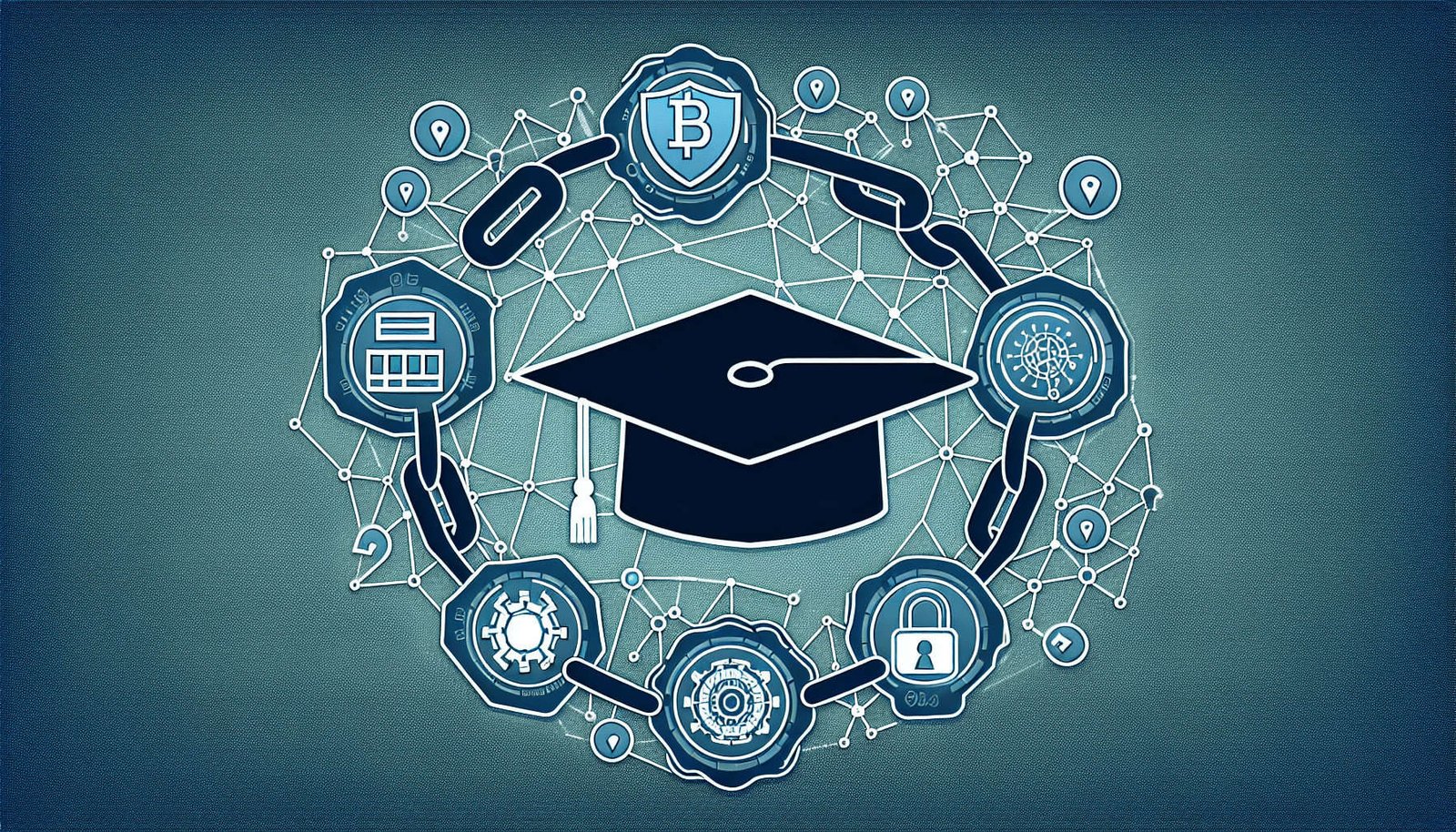Imagine a world where the process of verifying academic qualifications and professional certifications becomes seamless, transparent, and secure. With the advent of blockchain technology, that vision is quickly turning into a reality. Blockchain-based education credentials and certificates are transforming the landscape of education, allowing individuals to securely store and share their educational achievements with ease. No longer will you have to worry about lost or forged documents, as the immutable nature of blockchain ensures that your credentials are tamper-proof and easily verifiable. This article explores the exciting potential of blockchain in revolutionizing the way we authenticate and showcase our educational accomplishments.

What are blockchain-based education credentials and certificates?
Definition
Blockchain-based education credentials and certificates refer to digital records of educational achievements and qualifications that are stored and verified using blockchain technology. Unlike traditional paper certificates, these credentials offer enhanced security, transparency, and tamper-proof features.
Benefits
Blockchain-based education credentials and certificates offer several advantages over traditional paper certificates. They provide enhanced security, as the decentralized and immutable nature of blockchain technology makes it difficult for the records to be tampered with or manipulated. Additionally, these credentials offer transparency and verifiability, allowing employers and educational institutions to easily authenticate the authenticity of the certificates. Furthermore, blockchain-based credentials reduce the occurrence of fraud and fake certificates, ensuring the integrity of educational achievements. Lastly, these credentials provide ease of sharing and transferring, enabling individuals to effortlessly present their qualifications to potential employers or educational institutions.
Overview of blockchain technology
Blockchain technology is a decentralized digital ledger that records and verifies transactions across multiple computers or nodes. It operates on a distributed network, where all participants have access to a shared database and must agree on the validity of each transaction. Each transaction is stored in a block, which is linked to the previous block, forming a chain of blocks. This creates a transparent and immutable record of all transactions, making it highly secure and resistant to tampering.
How do blockchain-based education credentials and certificates work?
Issuance process
The issuance process of blockchain-based education credentials and certificates involves several steps. Firstly, the educational institution or authority creates a digital record of the individual’s educational achievements and qualifications. This record is then encrypted and stored on the blockchain, ensuring its security and integrity. Upon completion, the individual is provided with a unique identifier or cryptographic key that serves as proof of their credentials.
Verification process
The verification of blockchain-based education credentials and certificates is a streamlined and efficient process. Employers or educational institutions can use specialized software or platforms to authenticate the certificates by accessing the blockchain database. The cryptographic key or unique identifier associated with the certificate is used to retrieve the corresponding record from the blockchain. By verifying the record against the original issuance, the authenticity and validity of the certificate can be accurately determined.
Immutable and secure records
One of the key advantages of blockchain-based education credentials and certificates is the immutability and security of the records. Once a record is stored on the blockchain, it cannot be altered or deleted without the consensus of the participants. This ensures that the certificates remain tamper-proof and resistant to fraudulent activities. Additionally, the decentralized nature of blockchain technology eliminates a single point of failure, making it highly secure and reliable for storing sensitive educational information.
Advantages of using blockchain-based education credentials and certificates
Enhanced security
Blockchain-based education credentials and certificates offer enhanced security compared to traditional paper certificates. The use of cryptographic algorithms and decentralized storage ensures that the records are protected from unauthorized access and manipulation. This reduces the risk of identity theft or forged qualifications, as the digital certificates are highly secure and tamper-proof.
Tamper-proof records
Due to the immutable nature of blockchain technology, the records stored on the blockchain cannot be modified or deleted without consensus from the network participants. This feature makes blockchain-based education credentials and certificates tamper-proof, ensuring the integrity and authenticity of the qualifications. This provides employers and educational institutions with confidence in the validity of the certificates they receive.
Transparent and verifiable
Blockchain technology enables transparent and verifiable education credentials and certificates. The decentralized nature of the blockchain allows for public access to the records, ensuring transparency in the verification process. Employers and educational institutions can easily authenticate the credentials by accessing the blockchain and verifying the authenticity of the records. This transparency reduces the need for time-consuming manual verification processes and improves the efficiency of credential verification.
Reduced fraud and fake certificates
With the increasing prevalence of fake certificates and credential fraud, blockchain-based education credentials offer a solution to this problem. The tamper-proof and transparent nature of blockchain technology makes it extremely difficult for individuals to forge or counterfeit qualifications. The decentralized nature of blockchain networks ensures that no single entity has control over the records, reducing the risk of unauthorized modifications or fraudulent activities.
Ease of sharing and transferring
Blockchain-based education credentials and certificates provide individuals with ease of sharing and transferring their qualifications. With traditional paper certificates, individuals often face challenges in securely sharing their credentials with prospective employers or educational institutions. However, by utilizing blockchain technology, individuals can simply provide a unique identifier or cryptographic key that grants access to their digital credentials. This simplifies the process of sharing qualifications and increases the efficiency of credential verification.
Challenges and considerations in implementing blockchain-based education credentials and certificates
Integration with existing systems
One of the challenges in implementing blockchain-based education credentials and certificates is the integration with existing educational systems and infrastructure. Educational institutions may have established systems for issuing, managing, and verifying paper certificates, which would require significant changes to incorporate blockchain technology. The seamless integration of blockchain-based credentials with existing systems is crucial to ensure a smooth transition and widespread adoption.
Standardization and interoperability
To ensure the widespread adoption and acceptance of blockchain-based education credentials and certificates, standardization and interoperability are essential. Establishing common protocols, formats, and frameworks for blockchain-based credentials will enable easy verification and compatibility across different platforms and systems. Without standardization, the implementation and acceptance of blockchain-based credentials may be fragmented, hindering its potential impact.
Privacy and data protection
As blockchain technology operates on a decentralized network, there are concerns regarding privacy and data protection. Educational institutions must carefully consider how sensitive student information is stored and accessed on the blockchain. Implementing appropriate privacy measures, such as encryption and consent-based access, is crucial to ensure that personal data is protected and complies with privacy regulations.
Technical complexity
Implementing blockchain-based education credentials and certificates requires technical expertise and infrastructure. Educational institutions need to invest in the necessary technology, resources, and skilled personnel to develop and maintain the blockchain system. The complexity of blockchain technology may present challenges in terms of understanding, implementing, and maintaining the system effectively.
Costs and resources
Implementing blockchain-based education credentials and certificates can involve significant costs for educational institutions. Costs may include technology infrastructure, development, training, and ongoing maintenance. Additionally, educational institutions must allocate resources to ensure the successful implementation and adoption of blockchain-based credentials. Assessing the financial feasibility and allocating adequate resources are important considerations for educational institutions considering the adoption of blockchain-based credentials.
Real-world examples and pilots of blockchain-based education credentials and certificates
MIT Media Lab’s pilot
MIT Media Lab conducted a pilot project to explore the use of blockchain for issuing and verifying education credentials. The pilot involved issuing digital certificates to graduates of the program “Learning Creative Learning.” The blockchain-based credentials provided advantages such as decentralized verification and easy sharing with employers or other educational institutions.
Holberton School
Holberton School, a project-based software engineering school, has implemented blockchain-based education credentials using the Blockcerts platform. Students receive digital certificates upon completion of the program, and the credentials can be easily verified by potential employers or educational institutions. This implementation demonstrates the potential of blockchain technology in improving the validity and accessibility of education credentials.
Southern New Hampshire University’s College for America program
Southern New Hampshire University’s College for America program partnered with Learning Machine to develop blockchain-based education credentials. Students earn digital certificates for completing competencies and projects, which can be shared and verified easily with potential employers. The utilization of blockchain technology enables a seamless and secure system for recognizing and validating student achievements.
Learning Machine and MIT’s Blockcerts
Learning Machine and MIT collaborated to develop the Blockcerts open standard for blockchain-based education credentials. This open-source platform allows educational institutions to issue and verify digital certificates using blockchain technology. The adoption of Blockcerts by various universities and organizations showcases the potential widespread acceptance and implementation of blockchain-based education credentials.
Potential future applications and impact of blockchain-based education credentials and certificates
Streamlined hiring processes
Blockchain-based education credentials and certificates have the potential to streamline hiring processes by providing recruiters with easy access to verified and authentic qualifications. Rather than relying on manual verification processes, recruiters can quickly and accurately verify candidates’ credentials by accessing the blockchain. This can significantly expedite the hiring process and increase the efficiency of talent acquisition.
Global recognition and mobility
Blockchain-based education credentials have the potential to facilitate global recognition and mobility of qualifications. As the blockchain provides a transparent and immutable record of the credentials, individuals can easily present their qualifications to institutions or employers worldwide, eliminating the need for time-consuming and costly verification processes. This global recognition and mobility benefit both individuals seeking educational opportunities abroad and institutions looking to attract diverse talent.
Lifelong learning and micro-credentials
Blockchain-based education credentials can support lifelong learning and the acquisition of micro-credentials. As individuals engage in continuous learning and acquire new skills, blockchain-based credentials provide a secure and verifiable way to showcase these achievements. With the ability to issue and verify micro-credentials, educational institutions and employers can have a comprehensive view of an individual’s skills and capabilities.
Decentralized education systems
Blockchain technology has the potential to revolutionize the education system by decentralizing the issuance and verification of credentials. By removing reliance on centralized authorities, individuals can have greater control over their educational records and qualifications. This decentralized approach empowers individuals and reduces the risk of fraud or manipulation of credentials.
Empowering learners
Blockchain-based education credentials empower learners by providing them with ownership and control over their qualifications. Individuals can access and share their qualifications as needed, enhancing their employability and educational opportunities. This shift towards learner-centric credentials gives individuals greater agency in showcasing their skills and qualifications to potential employers or educational institutions.

Considerations for implementing blockchain-based education credentials and certificates
Collaboration between academia and industry
The successful implementation of blockchain-based education credentials requires collaboration between academia and industry. Educational institutions and authorities must work closely with blockchain technology companies and industry stakeholders to develop standards, protocols, and frameworks that align with the needs of both sectors. This collaboration ensures that blockchain-based credentials meet the requirements of employers and educational institutions while maintaining the integrity and security of the qualifications.
Standardization and guidelines
Standardization plays a crucial role in the widespread acceptance and adoption of blockchain-based education credentials. Establishing common protocols, formats, and guidelines ensures interoperability and compatibility across different platforms and systems. Standardization efforts should involve collaboration among educational institutions, technology companies, and regulatory bodies to develop robust and widely accepted standards.
Regulatory and legal frameworks
The implementation of blockchain-based education credentials must comply with regulatory and legal frameworks governing data privacy, security, and intellectual property rights. Educational institutions must ensure that the collection, storage, and sharing of student information on the blockchain adhere to existing regulations and laws. Establishing clear guidelines and frameworks for the ethical and legal use of blockchain technology in the education sector is essential for its successful implementation.
Costs and infrastructure
Implementing blockchain-based education credentials requires a financial investment in technology infrastructure, development, and maintenance. Educational institutions must assess the costs and benefits of adopting blockchain-based credentials and allocate the necessary resources to support their implementation. Adequate infrastructure, including network capacity and storage capabilities, is crucial to ensure the functionality and scalability of the blockchain system.
User acceptance and adoption
The successful implementation of blockchain-based education credentials relies on user acceptance and adoption. Educational institutions must engage with students, educators, employers, and other stakeholders to educate them about the benefits and functionality of blockchain-based credentials. Providing training and support to users and demonstrating the value of blockchain-based credentials will encourage their acceptance and adoption within the education ecosystem.
Steps for organizations and educational institutions to adopt blockchain-based education credentials and certificates
Assess needs and benefits
Organizations and educational institutions should begin by assessing their needs and understanding the benefits of implementing blockchain-based education credentials. They should consider the existing challenges in issuing and verifying traditional paper certificates and identify how blockchain technology can address those challenges effectively.
Establish partnerships
To successfully adopt blockchain-based education credentials, organizations and educational institutions should establish partnerships with technology companies, industry stakeholders, and blockchain experts. Collaborating with these partners will provide the necessary expertise, guidance, and support throughout the implementation process.
Design and develop the blockchain solution
Once partnerships are established, organizations and educational institutions can begin the process of designing and developing the blockchain solution. This involves defining the requirements, selecting the appropriate blockchain platform, and determining the technical specifications for the system.
Test and pilot the technology
Before fully implementing blockchain-based education credentials, organizations and educational institutions should conduct testing and pilot programs. This will allow them to identify any potential issues, evaluate the functionality and usability of the system, and gather feedback from users. Testing and piloting will help organizations refine the implementation and ensure its effectiveness.
Implement and integrate with existing systems
After successful testing and piloting, organizations and educational institutions can proceed with the implementation of blockchain-based education credentials. This involves integrating the blockchain system with existing educational systems, ensuring compatibility and seamless operation. Training and support should be provided to users to facilitate a smooth transition.
Educate and train stakeholders
To ensure the successful adoption of blockchain-based education credentials, organizations and educational institutions should educate and train stakeholders about the benefits and functionalities of the system. Training programs should be provided to students, educators, employers, and other relevant stakeholders to ensure they understand how to issue, verify, and utilize blockchain-based credentials effectively.
Monitor and continuously improve
After the implementation of blockchain-based education credentials, organizations and educational institutions should continuously monitor the system’s performance and gather feedback from users. Regular evaluation and improvement of the system will help address any issues, optimize functionality, and ensure the system remains secure and reliable.

Conclusion
In conclusion, blockchain-based education credentials and certificates offer numerous benefits, including enhanced security, tamper-proof records, transparency, and reduced fraud. While implementing blockchain-based credentials poses challenges such as integration with existing systems, standardization, and privacy considerations, the potential impact on streamlined hiring processes, global recognition and mobility, decentralized education systems, and learner empowerment cannot be ignored. Organizations and educational institutions can adopt blockchain-based credentials by assessing needs, establishing partnerships, designing and developing the system, testing and piloting, implementing and integrating, educating stakeholders, and continuously monitoring and improving. With careful consideration and collaboration, blockchain-based education credentials have the potential to revolutionize the way educational qualifications are recognized and verified.


